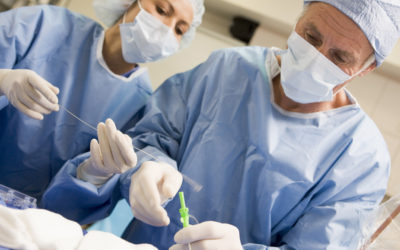Minimally Invasive Cardiac Treatment
Invasive cardiovascular procedures are tests or treatments that require something (catheter, needle, etc.) to be inserted into the body to perform a diagnostic test or to treat a disease or condition found from a diagnostic test. Because the procedures are invasive, they are performed by highly trained specialists.
Some of the procedures we perform include:
- Angiography – This is an X-ray exam of the blood vessels when they are filled with a contrast material. This procedure is performed to help doctors identify diseased, narrowed, enlarged and blocked blood vessels, and to determine where internal bleeding may be occurring.

- Coronary Angioplasty – A catheter carrying a balloon is inserted through an artery in the groin or arm into a blocked artery in the heart. The balloon is quickly inflated and deflated to open the artery to improve blood flow. Sometimes a stent – which is a mesh, metal tube – is implanted within the artery to keep it open after an angioplasty procedure.
- Cardioversion – This delivers an electric shock to the chest via electrodes or paddles in order to correct a dangerous heart dysrhythmia, which is an abnormality of the heartbeat that may be faster than normal.
- Cryoablation – This procedure uses extreme cold to destroy tissue where the arrhythmia originates.
- Electrophysiology (EP) study with or without ablation – An EP study is a procedure that examines the heart’s electrical activity and pathways. Radiofrequency ablation is a procedure that uses heat to destroy abnormal electrical pathways in the heart.
- Heart Failure Implantable Monitor – This wireless heart failure monitor system is implanted by the cardiologist in the pulmonary artery to measure pulmonary wedge pressure, which is the best indicator for worsening heart failure. The monitor has been proven to significantly reduce heart failure hospitalizations and improve quality of life.
- Implantable Cardioverter Defibrillator (ICD) – This device is implanted in the chest to continuously monitor the heart’s rhythm and provides therapy when life-threatening arrhythmia is detected. It also includes a pacemaker element to restore a normal heart rate.
- Intravascular Ultrasound – This imaging procedure passes sound waves from an ultrasound probe mounted on a catheter into the blood vessel to help determine the severity and type of blockage in the blood vessel. This is usually done in conjunction with a cardiac catheterization and angioplasty.
- Pacemaker Insertion – This small, battery-operated device helps maintain a normal heartbeat by sending electrical impulses to the heart.
- Percutaneous Peripheral Vascular Intervention – This minimally invasive procedure is performed through a skin puncture, usually in the groin, to treat peripheral arterial disease which occurs when plaque builds up in the arteries that carry blood to your head, organs and limbs.
- Transesophageal Echocardiography – This imaging procedure passes sound waves from an ultrasound probe in the esophagus to provide clearer images of the heart.
For More Information
Call 847-360-4239
Related Services and Conditions
Cardiology
Cardiac Care at Vista Health System focuses on the functions and disorders of the heart and its connected circulatory system. According to the American Heart Association, 84 million people in the U.S. suffer from some form of cardiovascular (heart) disease, affecting...
Cardiac Calcium Scoring Screenings
This screening is performed using a 64-slice CT scanner. The patient undergoes a simple scan of the arteries surrounding the heart. No injections, stress tests or medication necessary. The test evaluates the calcium buildup in the arteries surrounding the heart, thus...
Cardiac Catheterization
In a cardiac catheterization procedure, a small, hollow tube is inserted into a blood vessel. Once inserted, a number of procedures can be performed through the catheter, including measuring the pressure within the heart’s chambers, collecting biopsies, angiogram, and...
Cardiac Surgery
Cardiothoracic Surgery Cardiothoracic surgery treats diseases of the heart and lungs. These vital surgeries are performed at Vista Medical Center East by Vista's trained cardiac team, offering you specialized care for your heart right in your community. Coronary...
Cardio-Pulmonary Rehab Program
If you’ve been diagnosed with a heart-related condition, your doctor may decide to prescribe treatment to help strengthen your heart, reduce risk factors, inform you about healthy nutrition and safety precautions as you return home, and help you resume a normal or...
Congestive Heart Failure
What is Heart Failure? Heart failure is when the heart can’t keep up with its workload to meet the body’s needs for blood and oxygen. If the heart muscle is unable to pump enough blood, it can’t supply the cells with enough blood. This results in fatigue and shortness...
Diagnosing Your Heart’s Condition
This is the critical first step in your care. At Vista, physicians have advanced diagnostic capabilities to help determine the condition of your heart. Below are the tests that we use to help determine the health of your heart. Cardiac Stress Testing Cardiac stress...
Healthy Heart Program
The Vista Ambulatory Care Center, Lindenhurst, offers community members the opportunity to use professionally staffed rehabilitation exercise facilities to stay heart healthy and in shape. An exercise physiologist is available to customize your exercise routine to...
Post-Operative Care
Intensive Care Unit Following open heart surgery, patients are first brought to Vista’s Intensive Care Unit (ICU). It features a contemporary, functional design that keeps patients in direct view of the nurses’ stations. The ICU specializes in caring for patients with...









